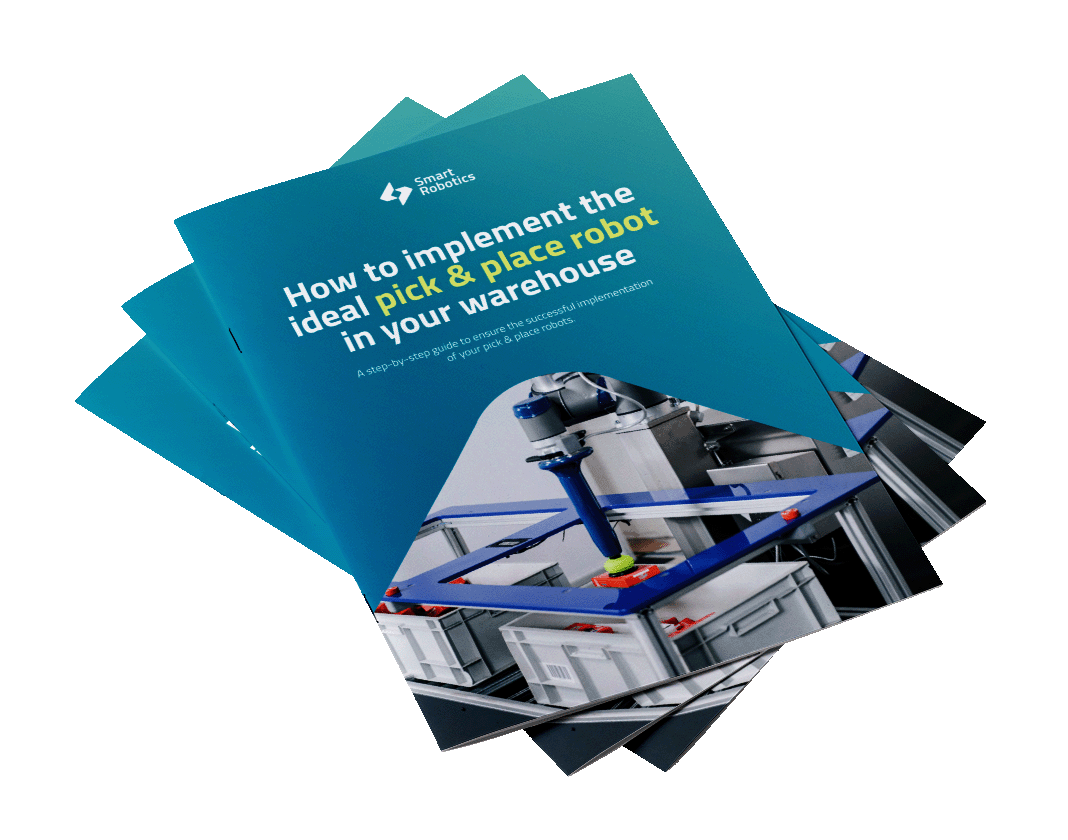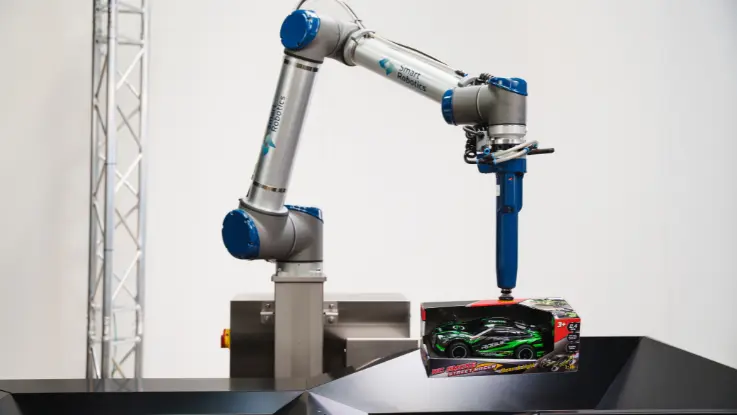Table of contents
Get in touch with our team

This site is protected by reCAPTCHA and the Google Privacy Policy and Terms of Service apply.

Warehousing 4.0: Deploying logistics at scale
Table of contents
Smart automation is accelerating the implementation of warehousing 4.0. When we consider what “4.0” points towards, a few fundamentals are encapsulated by “warehousing 4.0”. Firstly, across industry 4.0, there’s a focus on key value drivers, the empowerment of people, and renewed infrastructure. Industry 4.0’s goal is to introduce technologies or an integrated technology platform in the workplace to drive operations forward and to aid the human workforce via technological advancements.
In the warehouse sector, automation and robotics have already rolled out to improve the efficiency of logistical practices. Across industry, various fulfilment centres have adopted the practices of warehousing 4.0 by introducing robotics and automated warehousing processes. This not only provides relief towards the persisting labour shortage across logistics, but also aids the empowerment of warehouse employees. Robotics and automation makes it possible for employees to save time and direct their attention towards activities that demand greater attention than, for example, small batch order sorting. Take a look at our solutions.
Key driving trends of rolling out warehousing 4.0: Key driving trends
Welcome to the age of the smart warehouse. It’s been observed that there’s two important trends which drive transformation in logistics. Firstly, we’re experiencing a shift in the nature of fulfilment and distribution. For example, in online retail and e-commerce – customer expectations and order characteristics have impacted the way in which warehouse operations are fulfilled. It’s predicted that we’ll see a heightened level of small-batch production, as well as localisation and centralisation of warehouse centres.
This trend already demands for smarter warehousing systems to aid the functionality and productivity of fulfilment centres, as this is an integral part of efficient logistics planning. This trend is urging warehouses to adopt smart technology that is agile, integratable, responsive, and optimised for faster, plus more efficient, service deliveries.
Secondly, warehouse management and operational systems are already jumping on the wave of new technological innovations. Although the logistics industry is late to automation, compared to other tech industries, we’re seeing more and more collaborative and autonomous robotics, sensor technology, and the Internet of Things (IoT) converging to deploy logistics at scale, i.e., the smart warehouse.
Before setting off on your strategy to scale your business in logistics for the next industrial revolution, it’s important to note that a 4.0 warehouse is designed to reduce inefficiency and, as such, costly practices. With warehousing 4.0 rolling out, warehouses are also set to generate quicker ROI. Not only this, but also warehousing 4.0 best practices aim to increase productivity, prevent employees from engaging in strenuous tasks. A so-called “smart warehouse” essentially reduces employee time spent on physically and mentally draining tasks, as well as eliminates repetitive work done by humans which is not ergonomic. Thus, improving human productivity and the time capacity of their day.
As we’re approaching a new era of industry transformation, integrated and automated warehousing processes are needed to support Logistics at scale. Warehouses make up an important component of logistics. The fundamentals of warehouse processes include receiving, storing, sorting, picking, packing, and shipping parcels. Optimising these six processes will allow you to streamline your warehouse operation, reduce cost & errors, and achieve a higher perfect order rate.
Reimagine Warehousing Operations for Logistics at Scale
With the onset of new dynamic technologies being introduced to the market on a daily basis, the possibilities for tech-driven companies to adopt a technology-first business strategy are limitless. Speaking from a warehouse optimization perspective, deploying logistics at scale in preparation for industry 4.0, there’s some valuable factors to consider, all which contribute to efficient logistics planning.
-
Implementing smart technology in warehouses: collaborative robots (cobots)
Automation is already highly prominent in modern logistics. From automated picking tools, autonomous and robotic technology, down to the latest in human-friendly design – cobots. These collaborative robots are designed to work alongside humans, without posing a physical threat to health and safety. Cobots do not need to be fenced off and are capable of coexisting with warehouse employees.
What’s more is that, as you’re preparing to deploy your warehousing 4.0 strategy, cobots can easily be incorporated into the plan for equipment upgrades. They are designed with the purpose of not disrupting existing warehouse infrastructure. Infrastructure design can stay intact, while workflow is optimised by handing over physically demanding tasks to the cobots. Little oversight is needed and cobots can be managed by almost anyone – little knowledge of robotics is needed to engage cobots.
-
Introducing perception of vision, swift motion planning, and task planning robots
The trinity of robotics design (perception, vision, and task planning) is a vital aspect of automation and robotics engineering to consider as we prepare for warehousing 4.0. Though technology is becoming more freely available, modern robotics design and systems planning is becoming more specialised in some areas of robotics engineering.
Perception of vision, swift motion planning, and task planning are mostly built into modern robots. Robots that bring these characteristics into play are able to scale up warehouse efficiency – operating at a greater level than what human performance accounts for.
The benefits of investing in the robots for logistics optimization and in prep for warehousing 4.0 is that, for example, parcel picking, sorting and stacking is done quicker and with more accuracy. Parcels reach their next destination in the warehouse quicker and can thus be shipped out faster to their next point of call.
Task planning robots mimic human behaviour, for instance, the robot is able to calibrate and correct itself, as a person would, although with little human involvement needed to assist the robot in reevaluating the task being performed. This lessens the error margin in parcel handling.
-
Innovating warehouse architecture
The latest industry revolution is focusing on cost-effective robotics and automation to upgrade warehousing infrastructure. Warehouse operations are redefining how market needs are met, automation is but one step taken to save space and improve productivity in the warehouse. For example, investing in automated depalletization and palletization processes is becoming more common practice across the industry. This is enabled by automated palletizers operating against lower costs whilst delivering a higher production volume. Higher throughput equals economic viability.
Those in e-commerce probably understand the challenges faced in keeping up with market demand the best. The industry experiences fast enough throughput to validate investing in automation, however, warehouses for e-commerce companies need to house a great variety of diverse products, not to mention having to compensate for seasonal demand. The fact is e-commerce needs to innovate warehouse architecture to adopt smart technologies, for the purpose of accommodating high and/or fluctuating throughput.
The benefit is that smart automation is highly flexible in terms of parcel handling, adapting to- and integrating with existing warehouse infrastructure, as well as interacting with human employees.
Advice for warehouses on strategically deploying logistics at scale
The first step is to determine how you would bridge the gap between manual and automated processes. It’s advised to gradually adopt a tech-driven approach to warehouse management and automation. The crossover from manual- to automated assistance is a marathon, rather than a sprint.
The goal is to empower warehouse employees by introducing new technologies to support their day-to-day conducts. From a managerial perspective, remembering the fundamentals of warehousing 4.0 is critical. The latest industrial revolution does not aim to worsen the labour shortage, it grants the opportunity to create new possibilities for employees, via automated and robotic assistance.
On this, flexible automation is one option warehouses can introduce to meet their goals, while contributing to the physical safety and mental health of employees – relieving employees from monotonous activities.
To recap, warehousing 4.0 enables adaptable, automated systems that can work with humans, not against them. The latest industrial revolution sets out to optimise resources, minimise errors, allow for more agile production, and aid employees by optimising their schedules. A smart warehouse assists human performance in that it automates repetitive tasks by introducing robotic technologies. Warehouse employees are thus able to focus on more delicate and meticulous tasks.
In conclusion, deploying logistics at scale, in accordance with warehousing 4.0, will require patience and should not be rushed. If you’ve missed the first industry wave to automate, it’s not over. Prioritising areas of improvement is key in creating a smart warehouse, staying flexible and focusing on resource productivity and efficiency is one of the best practices in creating valuable opportunities for employees, whilst aiming to leverage smart technologies. As a final thought, as you move from manual to automated processes, data mitigation will require a heightened level of attention. Warehousing 4.0 therefore demands a strategic, regulatory framework to deploy logistics at scale, as well as asks for the standardisation of interfaces and harmonising business processes.
Get in touch with our team

This site is protected by reCAPTCHA and the Google Privacy Policy and Terms of Service apply.
Download our free white paper
Learn how to implement the ideal pick & place robot in your warehouse. Leave your contact details and receive a download link to our free whitepaper.






